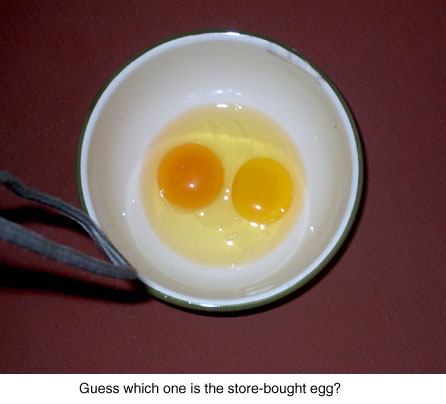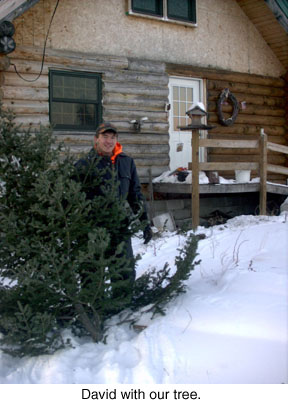
Why with all that science, can’t factory chickens lay a good egg???
This morning, Mom wanted some scrambled eggs and bacon. I had one store egg left from those I’d bought to make deviled eggs. (For ease, you need OLD eggs to make peeling eggs less of a chore.) And, of course, I had plenty of green eggs, blue eggs and a few brown eggs. Yes, I have Arucana chickens, which lay colored eggs, as well as assorted brown-egg-laying heavy breed hens. The color really doesn’t matter much, but it’s just fun to have the different colors.
“Factory chickens” get the latest ground diet, scientifically proven to be the best for them. Mine get bugs, milk and weeds in the summer and kitchen left-overs, milk and snow in the winter. Of course, they also get a little scratch feed, as well. They do have grit, oyster shell and water available, too. Not terribly scientific, huh?
But yet, when I broke the two eggs into a bowl, the store egg was (as they always are!) pale yellow, with a watery white. My homestead egg was orange with a nice thick, firm white. Gee, could a natural lifestyle be better for chickens???? The proof is in the egg.
A lesson for mankind, all wrapped up in an egg shell.
Tonight, when David got home from school, we went out into the woods and searched for the perfect Christmas tree. Living on previously logged off land, there are lots and lots of potential Christmas trees, just the right size to choose from. And it’s always a hard decision. But finally, we agreed on a nice bushy white spruce and David cut it, leaving about three feet of trunk. (The tree won’t be killed, but will sprout two new trees from the trunk. We’ll prune one off, leaving another nice tree to grow up later on.)

We brought it home and now I’m cleaning and re-organizing our living room so we can bring in the tree tomorrow night. Everyone is always excited when we decorate our fresh, homegrown tree. It’s even more like Christmas when we get to cut our very own tree! Our Christmas will be simple this year. We’re lightening up on the gift giving and enjoying more visiting and eating. Sometimes, in the past, Christmas got too depressing as we joined the rat race of GIVE MORE! So we have made a decision to simplify our holiday season so we can enjoy it much more. After all, it’s only 2 1/2 weeks till Christmas! Hmmmm. Then it’s New Year’s….and February pepper planting, then SPRING!!!
Readers’ questions:
Cake in a jar
Jackie, would you mind sharing your recipes for cake-in-a-jar and processing times? Since I enjoy canning, I always like to experiments with a new recipe, plus having cake handy for unexpected
company, is always a nice treat. Thanks; always love and respect your canning advice. Merry Christmas and Happy New Year to you and your family!
Andrea Del Gardo
Myrtle Beach, South Carolina
Because of the experts warning about canning cakes in a jar, I can’t give you recipes; I just used any instant bread, such as banana bread, lemon bread, etc. The wide mouthed pint jars were lightly greased and filled about half to 2/3 full. The jars were then set in the oven and baked at 350 degrees, till done. IMMEDIATELY when taken out of the oven, the hot, previously simmered lids were placed on the jars and the rings screwed down firmly tight. The jars sealed as they cooled. But I really can’t give you this information. — Jackie
Eliminating rodents
My little homestead in the Ozarks is inundated with mice, rats, squirrels, and bats. The bats have found a way up into the attic of my house and I don’t have a clue on how to get them to find another
abode. Any advice on how to rid my place of the above? Thanks for your blog. I check it daily for your news and wisdom.
Bonnie West
Norfork, Arkansas
Sounds like you need to either set a good trap line or find a good cat! To get rid of the rodents, eliminate their feed as a starting point. They’ll likely leave if they can’t get into the grain, livestock feed or other edibles, including sunflower seeds in your bird feeder.
As for the bats, crawl up in the attic on a sunny day, armed with a couple of bags of steel wool and a can of foam insulation. A bat can crawl through a crack half an inch in diameter, so look about for cracks, often along your chimney flashing or at the eaves. Stuff the steel wool in the crack, then hold it in place with the foaming insulation, which hardens and swells to seal tightly. You may need to do this more than once, but you’ll see a drastic decrease in bat population in the house each time you go bat-proofing.
I really like bats (but not in the house!). They eat an incredible amount of insects each night and are interesting creatures to watch. You might consider hanging a few bat boxes up under the eaves of your outbuildings. This may encourage the recently evicted bats to take up better housing. Good luck. — Jackie
Keeping cats healthy
We recently were given four kittens to be barn cats and mousers. We have only been on this ranch a few months and know we risk predator losses, but do you or BHM have information on natural ways to keep pets healthy, such as what to use for worming?
Your parts of the magazine are the best and most interesting to me, and you are an amazing woman both for knowledge an experience. (Know any single young women who are looking for a partner? My son is afraid I’ll die and leave him with no one to share with!)
Donald Allen
Afton, Texas
Congratulations on your move to ranching. Having been a veterinary technician for over 20 years, I’ve seen and tried a lot of natural wormers, etc. Unfortunately, few have really done their job. I’ve had people tell me they used XXXXX and their cat was now totally worm free and healthy. But when I asked if they’d taken a fecal sample in to their vet to have it checked following the treatment, every one hemmed and hawed around and ended up saying that they KNEW their cat was now worm free and healthy. Not good enough for me.
The ONE huge thing you can do to keep your cats healthy is to have them neutered when they reach six months of age (males) or four months (females). Why would neutering them keep them healthy? Because a whole lot of sickness and injuries are the result of the cats’ contact with feral cats during breeding activities.
Also, a female can have two litters of kittens a year, with an average litter of five. Not only will you soon be overrun with cute kittens, soon to be not-so-cute cats, but the mother cats will become stressed from being pregnant so often and nursing untold litters of kittens.
It is a fable that mother cats are the “best” mousers. Just like “hungry cats make the best mousers”. Not so. Neutered cats will mouse very effectively and healthy, well nourished cats will be in top shape to hunt happily.
It’s a very good idea to have your kittens vaccinated against the most common cat diseases. One of the most frequently encountered is feline distemper. While a cat can recover from it, few actually do. This is a very “hot” disease and is easily passed from a neighboring or feral cat passing though your yard and having fleeting contact with your own cats. Talk to your vet. The vaccinations are not expensive and will probably save your cats’ lives. — Jackie
Encyclopedia of Country Living
I realize you are very busy like all of us who have animals and such. My question is what books would you suggest for raising both chickens and rabbits? I have been trying to find them through our
local library but they don’t have what i need. I have been trying to find out how may sq ft are needed in the building for each chicken and whether rabbits need to be inside a building in cold country. So
far haven’t located either information. Good luck on your place and hopefully someday I will also get to the country once again.
Deborah Glass
Wrangell, Alaska
A very good homestead book that covers raising rabbits and chickens, as well as a million other useful things, is The Encyclopedia of Country Living by Carla Emery.
Basically, it’s recommended that laying hens need 1.5 sq. ft. of room inside and 8 sq. ft. in outside runs. There should be one nest per every 5 hens.
Rabbits can take a lot of cold, provided that they have shelter from the wind and cold. I always brought my hutches into my lean to barn after Thanksgiving, as in Minnesota, the weather soon turns from autumn-like to winter, with sub-zero temperatures. But my lean to was unheated and just provided shelter from the frigid winds and blowing snow. Given a nice nest box and lots of straw or shavings, rabbits do quite will during the winter. — Jackie


